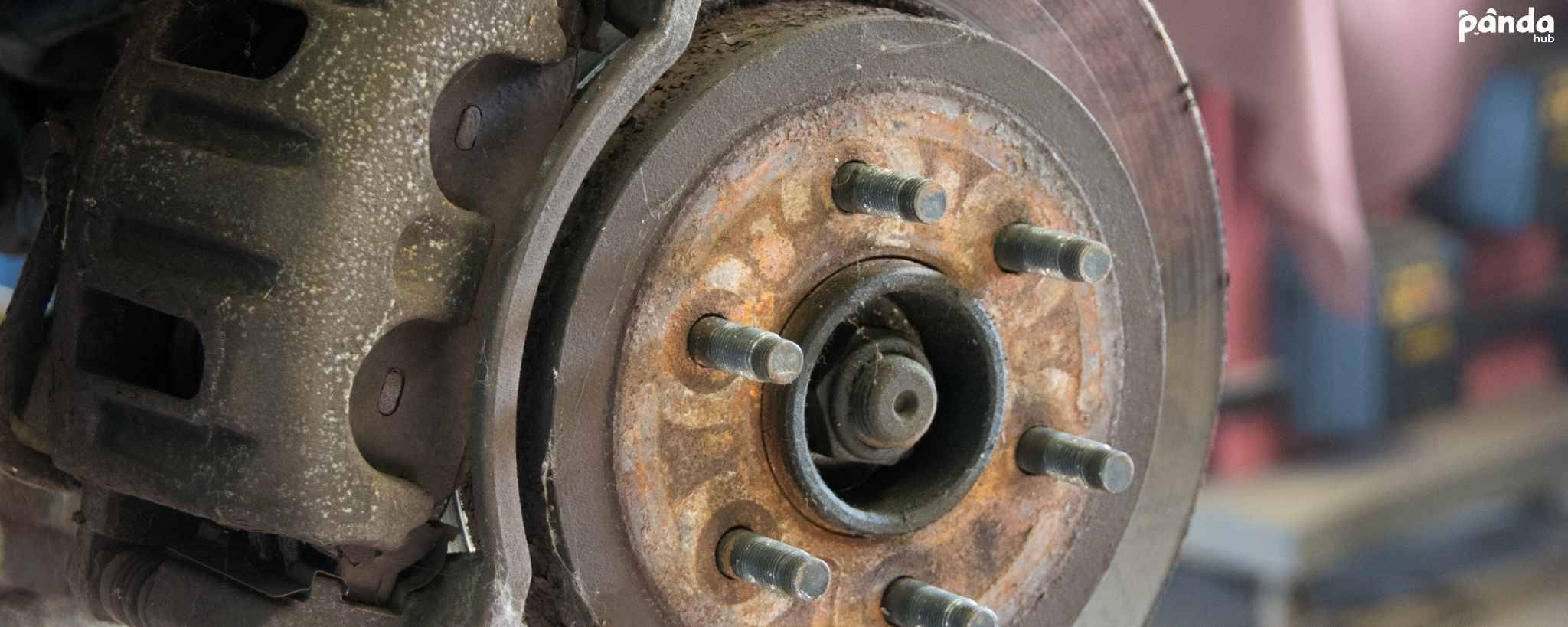How to Clean Rusty Brake Rotors
Looking for some expert tips to clean rusty brake rotors? Search no more! Here's what you need to know about why the rotors are rusty and how to clean them!

Written by:
Parham Koukia,
June 10, 2025
Use AI to summarize this article:
After a rainy weekend or a long stretch of parking your car outdoors, you might notice orange spots forming on your brake rotors. This rust on brake rotors is often gritty to the touch and can affect the sleek look of your alloy wheels, raising questions about your vehicle’s braking performance.
Rust on brake rotors is a common issue for car owners, particularly in humid climates or areas with high road salt usage. This guide explains whether you should worry about the rust on the brake components!
Why Do Brake Rotors Get Rusty?
Brake rotors are typically made of cast iron or steel and contain iron that reacts with oxygen and moisture to form rust, a flaky, orange coating. This rusting process is called iron oxidation and happens naturally when water sits on the rotor’s surface.
Common Causes of Rust Buildup in Vehicles
Some of the common causes of rust on your car’s brake rotors are:.
- Parking outdoors in humid areas, especially near the ocean, exposes rotors to constant moisture.
- Frequent Driving through road salt in winter speeds up rotor oxidation.
- Leaving your car undriven for weeks, such as during a vacation, allows rust to build without the natural cleaning from braking.
- Improper car washing and drying techniques can lead to rust formation in rotors.
Related Article: Brake Dust: Causes and Prevention
Is Rust on Brake Rotors Harmful?
Surface Rust vs. Heavy Rust: What’s the Difference?
Surface rust is a thin orange layer that often appears after rain or a car wash and is harmless. It’s scraped off by brake pads during normal driving, as the pads press against the rotor to slow your vehicle.
Heavy rust, however, forms deep, pitted patches when rotors sit unused for months or face constant salt exposure, potentially weakening the rotor’s structure.
Risks of Ignoring Excessive Rotor Rust
Heavy rust can cause uneven brake pad wear, reducing braking efficiency and leading to vibrations or noises when stopping.
Over time, it may thin the rotor below the manufacturer’s minimum thickness specification, typically around 20-30 mm for most vehicles, making brakes less effective.
In extreme cases, severe rotor corrosion can compromise braking.
How to Clean Rusty Brake Rotors: A Step-by-Step Guide
Below are the three methods to clean different levels of rust on brake rotors:
Method 1: Quick Cleaning Without Removing Wheels
For light surface rust, you can clean rotors without major disassembly.
Spray a brake cleaner, a solvent designed for automotive brakes, onto the rotor through the wheel’s gaps.
Wipe with a clean microfiber cloth to remove the loosened rust, keeping your alloy wheels spotless.
- Park your car on a flat surface and engage the parking brake.
- Spray brake cleaner generously on the rotor, aiming through the wheel spokes.
- Wipe the rotor with a clean microfiber cloth to remove rust and residue.
Method 2: Thorough Cleaning by Removing Rotors
For moderate rust, removing the rotors ensures a deeper clean.
You’ll need a jack, lug wrench, and wire brush. This method reaches all rotor surfaces, including areas covered by brake calipers.
- Loosen lug nuts, jack up the vehicle, and remove the wheel.
- Unscrew and remove the brake caliper, hanging it securely to avoid damaging the brake line.
- Spray brake cleaner, scrub with a wire brush, and wipe clean before reassembling.
Method 3: Soaking Rotors in White Vinegar for Deep Rust
For stubborn, heavy rust, soak it in white vinegar to dissolve the corrosion effectively. This method requires removing the rotor and takes longer, but give excellent results.
- Remove the rotor as described above and place it in a large bucket.
- Submerge the rotor in white vinegar, soaking for 12-24 hours to loosen rust.
- Scrub with steel wool, rinse thoroughly, and dry before reinstalling.
Safety Tips for Handling Brake Cleaner and Tools
Always work in a well-ventilated area, as brake cleaner fumes are strong.
Wear nitrile gloves and safety glasses to protect your skin and eyes from chemicals and rust particles.
Use a jack stand with your floor jack to ensure the vehicle stays secure while elevated.
Comparing Most Common Rust Removal Methods: Which Works Best?
Choosing the right cleaning method depends on rust severity and your available time and tools.
Brake Cleaner vs. White Vinegar: Speed and Effectiveness
While brake cleaner is a fast-acting solvent, it removes light rust in minutes but struggles with deep corrosion.
White vinegar, on the other hand, takes hours but excels at dissolving heavy rust, especially in pitted areas.
For quick fixes, brake cleaner might work the best, but for thorough restoration, you might want to give vinegar a try!
Steel Wool vs. Wire Brush: Choosing the Right Tool
Steel wool, available in fine (#000) to coarse (#3) grades, gently removes surface rust without scratching rotors. A wire brush, especially when attached to a drill, tackles stubborn rust but may leave minor abrasions.
Start with fine steel wool and switch to a wire brush for tougher spots, finishing with a light polish.
How to Prevent Rust on Brake Rotors Long-Term
Apply Protective Coatings to Rotors
After cleaning, apply a rust-resistant coating, such as a spray-on zinc-based protectant, to the rotor’s non-braking surfaces (the hub area).
Clean the rotor thoroughly, tape off the braking surface to avoid contamination, and spray evenly.
This creates a barrier against moisture buildup and road salt.
Upgrade to Coated Aftermarket Rotors
Coated aftermarket rotors, often treated with zinc or polymer, resist rust better than standard cast iron rotors. They cost about $20-$30 more per rotor but last longer in harsh conditions, like coastal areas. Brands like Wagner’s E-Shield rotors offer enhanced corrosion resistance, per their 2023 product testing data.
Maintenance Habits to Minimize Rust Exposure
Park your car in a garage to shield rotors from rain and humidity. Drive regularly, even for short trips, to let brake discs clear surface rust. After winter driving, rinse wheels with a hose to remove gritty road salt, drying rotors with a quick drive to prevent rust buildup.
Frequently Asked Questions About Rusty Rotors
What is the Best Brake Cleaner for Rusty Rotors?
CRC Brakleen can be a good choice for removing grease initially. It removes oil, grease, and rust deposits without leaving residue. Its high-pressure spray helps dislodge surface rust effectively, making it ideal for cleaning before reinstallation or resurfacing.
Can You Put WD-40 on Rusty Rotors?
We don’t recommend putting WD-40 on rusty rotors as it leaves a residue that reduces braking efficiency and can contaminate brake pads. Remove rust using brake cleaner or sanding.
Only use WD-40 on non-braking surfaces or as a temporary rust inhibitor before full cleaning.
Are Rusty Rotors a Sign of Poor Vehicle Maintenance?
Not always. Surface rust is normal in wet or high-humidity conditions, even on regularly maintained cars. Excessive rust, however, may indicate negligence, such as leaving a car undriven for months or ignoring salty road residue.
How Often Should You Check for Rotor Rust?
Inspect rotors every 3-6 months, especially after winter or prolonged parking.
Look for orange spots or pitting through wheel spokes. Regular checks catch heavy rust early and prevent costly repairs.

Parham Koukia
Lead Car Detailer / Operations Manager
With nearly 15 years of hands-on detailing experience, Parham has become a trusted authority in the auto care world. His work is regularly spotlighted in leading outlets like CNN, GoBankingRates, and Family Handyman. Parham likes to share his knowledge to offer in-depth tips on equipment selections, seasonal car care, and some secret car cleaning tips used by detailers in the real world!
Read more
